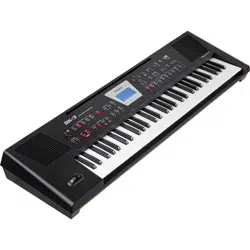Loading ...
Loading ...
Loading ...

Menu options
60
Parameter Setting
SMF Position Tx O, On (Default setting: O )
Visual Control Tx
Allows you to set the MIDI transmit channel for the Visual Control
function. (The BK-3 does not receive Visual Control messages.)
Parameter Setting
Visual Control Tx 1~16 (Default setting: 16)
See “18. Controlling Video Equipment (Visual Control)” (p. 61).
Checking a Tone’s or Rhythm’s MIDI
Address
Tones and rhythms can also be selected via MIDI. To this eect, they use
an “internal” address, which is not usually displayed. For MIDI applications
involving sequencers or external controllers, knowing the “ocial” address
may come in handy. The BK-3 has a handy system that provides this
information instantly—there is thus no need to look up the MIDI address
in the tables at the end of this manual.
1. Select the Tone or Rhythm whose MIDI address you need
to know.
(Tone selection window) (Rhythm selection window)
2. Press and hold the [NUMERIC] button to call up a pop-up
window.
(Tone selection window) (Rhythm selection window)
3. Press the [EXIT] button (or press [NUMERIC] again) to
return to the previous page.
Factory Reset
The following function allows you to recall the BK-3’s original
factory settings. This has no eect on the data stored on a USB
memory
1. Press the [MENU] button.
The display changes to:
2. Use the [UP] or [DOWN] button to select the “Factory
Reset” entry, then press the [ENTER] button.
3. Use the [INC] or [DEC] button to select “YES”, then press
the [ENTER] button to load the factory settings.
Select “NO” to return to the previous display page without loading
the factory settings.
A conrmation message informs you that the BK-3 has been
initialized.
Formatting a USB memory
This function allows you to format the connected USB memory.
USB memories using the FAT-32 le system may not need to be
formatted. We nevertheless recommend formatting all new USB
storage devices with the BK-3.
IMPORTANT NOTE
Formatting a USB memory means that all les (songs, rhythms,
etc.) it contains are lost.
Always check the contents of the memory before deciding to
format it.
1. Connect the a USB storage you want to format device to
the USB MEMORY port on the BK-3’s rear panel.
2. Press the [MENU] button.
3. Use the [UP] or [DOWN] button to select the “Format USB
Device” entry, then press the [ENTER] button.
4. Use the [INC] or [DEC] button to select “YES”, then press
the [ENTER] button to format the USB memory.
A conrmation message informs you that the USB memory has
been formatted.
The following folders are created on the USB memory
Folder Name Description
My Performances
This folder is used to save Performance Lists. (The
contents of this folder cannot be viewed by pressing
the [USB MEMORY] button. You need to press the
PERFORMANCE [LIST] button gain access to the les it
contains. The contents can be viewed on a computer,
however.)
My Recordings
This folder is used to store your audio recordings. See
“16. Recording your performance as audio data” (p.
41).
My Rhythms
This folder can be used to save rhythms you edited
with the “Makeup Tools” functions. See “Makeup Tools
(rhythms and SMF)” (p. 53).
My Songs
This folder can be used to save SMF songs you edited
with the “Makeup Tools” functions. See “Makeup Tools
(rhythms and SMF)” (p. 53).
NOTE
We recommend copying the contents of your USB memory to your
computer before formatting it.
Loading ...
Loading ...
Loading ...
